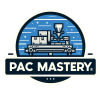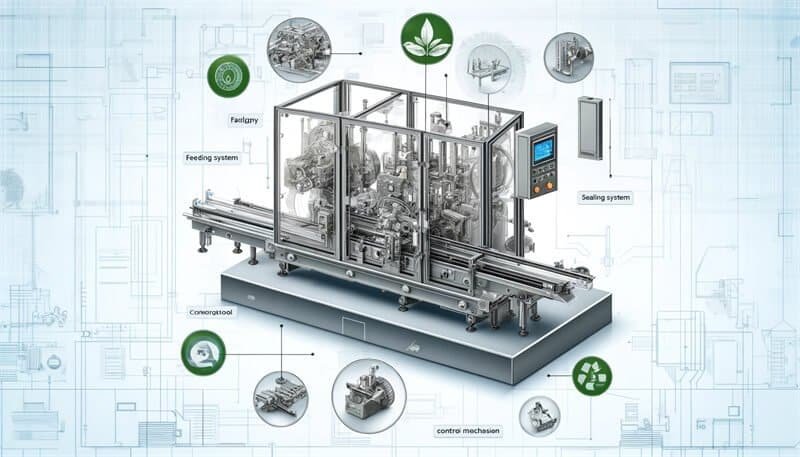At PacMastery, our mission is to revolutionize the packing machinery industry through innovative solutions, unparalleled quality, and relentless dedication to customer satisfaction. We strive to empower businesses around the globe with cutting-edge technology and customized machinery, ensuring efficiency, reliability, and excellence in every packaging process. Committed to sustainability and ethical practices, we are not just building machines; we’re crafting a more efficient, productive, and responsible future in packaging.
Key Takeaways
| Question | Answer |
|---|---|
| What are the types of packing machines? | Vertical Form Fill Seal (VFFS) Machines, Flow Wrapping Machines, Shrink Wrapping Machines, Tray Sealers, Palletizers, Biscuit Packing Machines |
| What are the key components? | Frame and Structure, Feeding System, Sealing Mechanism, Control System |
| How to design a custom packing machine? | Identify needs (product type, packaging material, production speed), customize components, and integrate with existing production lines |
| What are the benefits of custom packing machines? | Tailored solutions for specific needs, higher efficiency, reduced labor costs, increased productivity, long-term savings |
| What trends are driving the packaging industry? | Automation and Robotics, Sustainability, Advanced Technologies |
| What are the cost considerations? | Initial investment, long-term savings, efficiency gains, reduced product waste |
| How to ensure quality in packing machines? | Prototyping, thorough testing, regular maintenance, adherence to industry standards |
Introduction
Packing machines are pivotal in various industries, ensuring that products are securely packaged, preserved, and transported efficiently. Custom-made packing machines tailored to specific business needs offer unparalleled advantages in terms of efficiency, cost savings, and adaptability.
Types of Packing Machines
Understanding the different types of packing machines is essential for selecting the right one for your needs. Here are some common types:
Vertical Form Fill Seal (VFFS) Machines
VFFS machines are designed for high-speed packaging of products like granules, powders, and liquids. These machines create packages vertically, making them ideal for a wide range of products.
Flow Wrapping Machines
Flow wrapping machines wrap products in a continuous plastic film, forming a secure, pillow-like package. They are widely used for packaging food items like candies and snack foods due to their speed and efficiency.
Shrink Wrapping Machines
Shrink wrapping machines use heat to shrink plastic film around a product, creating a tamper-evident seal. This method is popular for packaging items like water bottles and cosmetics.
Tray Sealers
Tray sealers are used to package products like meat, fish, and ready meals. The product is placed in a tray and sealed with a lid or film, creating a protective, airtight environment.
Palletizers
Palletizers stack products onto pallets for easy transportation and storage. They are used across various industries to improve warehouse efficiency and reduce labor costs.
Biscuit Packing Machines
Biscuit packing machines are specialized for packaging biscuits in various configurations, such as family packs and bulk packaging. They ensure that biscuits are securely packed and remain fresh during transportation.
Designing Your Packing Machine
Creating a custom packing machine involves several critical steps:
Identifying Your Needs
- Product Type: Determine whether you are packaging granules, liquids, powders, or other products.
- Packaging Material: Choose the appropriate material, such as plastic film or eco-sustainable options.
- Production Speed and Volume: Assess the required speed and volume to ensure the machine meets your production goals.
Key Components of a Packing Machine
- Frame and Structure: Choose durable materials for the machine's frame to ensure longevity.
- Feeding System: Select the right feeding system, such as vibratory feeders, conveyor belts, or rotary disc feeders, based on your product type.
- Sealing Mechanism: Decide on the type of seals (e.g., heat seal, cold seal) required for your packaging.
- Control System: Implement a PLC (Programmable Logic Controller) and consider automation options to enhance efficiency.
Customization and Flexibility
- Adjustable Settings: Ensure the machine can be adjusted for different product sizes and shapes.
- Integration: Make sure the custom machine integrates seamlessly with your existing production lines to streamline operations.
Building Your Packing Machine
Prototyping
Create a prototype based on the design specifications. Test the prototype for functionality and efficiency, making necessary adjustments.
Assembly
Follow a step-by-step assembly process, ensuring precision and quality control at each stage to build a reliable packing machine.
Automation and Programming
Program the PLC for desired operations, incorporating sensors and automation features to increase efficiency and reduce manual intervention.
Testing and Quality Assurance
Ensuring your packing machine operates efficiently and safely is crucial. This involves thorough testing and adherence to quality standards.
Initial Testing
- Sample Testing: Use sample products to test the machine’s performance, ensuring it meets the required specifications.
- Calibration: Make necessary adjustments and calibrations based on test results to optimize performance.
Quality Assurance
- Industry Standards: Ensure the machine complies with industry standards and safety regulations.
- Reliability: Regularly maintain and inspect the machine to ensure long-term reliability and functionality.
Innovations and Trends in Packing Machines
The packing machinery industry is constantly evolving, driven by technological advancements and changing market demands. Here are some key trends:
Automation and Robotics
- Robotic Integration: Modern packing machines increasingly incorporate robotics for tasks such as product feeding and packaging, enhancing speed and precision.
- Automated Systems: Automation minimizes human intervention, reducing labor costs and increasing productivity.
Sustainability
- Eco-friendly Materials: The industry is shifting towards sustainable packaging materials to reduce environmental impact.
- Sustainable Practices: Emphasis on sustainable manufacturing processes and energy-efficient machines.
Advanced Technologies
- Artificial Intelligence: AI and data analytics are being used to optimize packaging processes, improving efficiency and reducing waste.
- Smart Packaging: Innovations in smart packaging solutions, such as tamper-evident features and interactive packaging, are gaining popularity.
Cost Considerations
Investing in a custom packing machine involves various cost factors. Understanding these can help you make informed decisions.
Initial Investment
- Cost Breakdown: Consider the cost of design, prototyping, assembly, and automation when budgeting for a custom packing machine.
- Comparison: Evaluate the benefits of a custom machine against purchasing a pre-made one to ensure it aligns with your financial goals.
Long-term Savings
- Efficiency Gains: Custom machines tailored to your needs can significantly improve efficiency and productivity, leading to long-term savings.
- Reduced Labor Costs: Automation reduces the need for manual labor, lowering operational costs.
- Minimized Waste: Precise packaging reduces product waste, contributing to cost savings.
Expert Tips for Success
Leveraging expert advice can ensure the success of your packing machine project. Here are some tips:
Selecting the Right Components
- Quality Materials: Choose high-quality materials for durability and efficiency.
- Compatibility: Ensure all components are compatible with your specific packaging needs.
Maintenance and Upkeep
- Regular Maintenance: Implement a regular maintenance schedule to keep the machine in optimal condition.
- Troubleshooting: Train staff on basic troubleshooting to quickly resolve any issues that arise.
Adapting to Market Changes
- Stay Updated: Keep abreast of industry trends and technological advancements to remain competitive.
- Flexibility: Design your machine with flexibility in mind to accommodate future changes in product lines or packaging requirements.
Conclusion
Investing in a custom packing machine tailored to your business needs can revolutionize your packaging process. By understanding the types of packing machines, designing with key components in mind, and leveraging the latest innovations, you can enhance efficiency, reduce costs, and ensure long-term reliability. At PacMastery, we are committed to helping you achieve these goals with our state-of-the-art packing machinery solutions.



